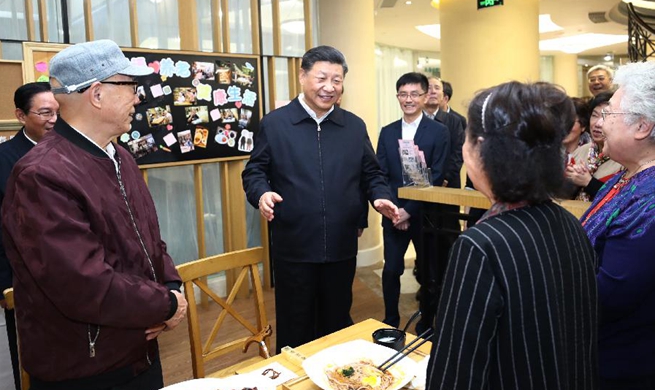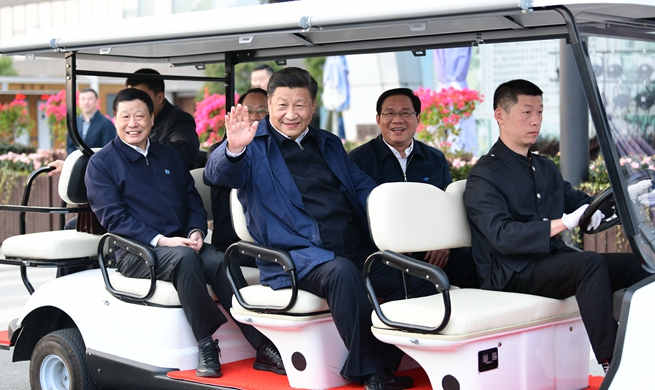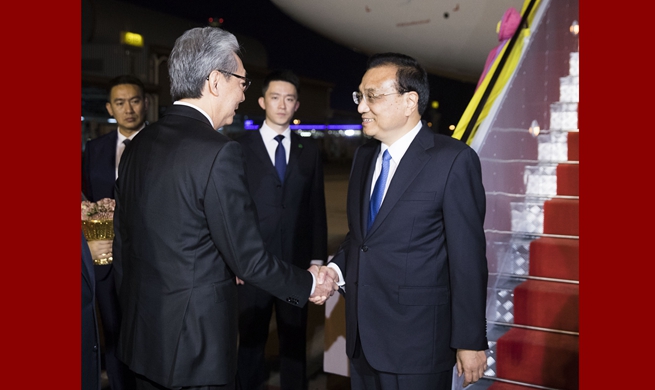by Xinhua writers Gao Wencheng, Zhang Jianhua, Zhang Yujie
VIENTIANE/CHANGSHA, Nov. 3 (Xinhua) -- Born in a Miao ethnic enclave in the central Chinese Province of Hunan, 69-year-old Shi Basan lived most her life in the shadow of peaks.
While Shi's homeland is rich in natural beauty and scenic landscapes, the rugged terrain causes her village of Shibadong to suffer from a lack of transportation and arable land.
On the outskirts of the Lao capital of Vientiane, a river divides the mountainous village of Ban Xor into two parts.
A dilapidated wooden bridge across the river held Thongvieng Panmany, a 57-year-old villager who lives by the river, back from pursuing her dreams of expanding farming on the other side.
Far away in distance but near in heart, Shi and Thongvieng share a common aspiration: to rid themselves of poverty.
ONE VILLAGE, TWO PRESIDENTIAL VISITS
Before Nov. 3, 2013, Shi never dreamed that she would meet with two heads of state.
On that day, during an inspection tour to Hunan, Chinese President Xi Jinping visited the then poverty-stricken Shibadong village.
Shi still remembers that when Xi, also general secretary of the Communist Party of China Central Committee, visited her dark house, the only electrical appliance was a 5-watt energy-saving light bulb.
"What should I call you?" asked illiterate Shi, as she welcomed Xi into her home.
"I am a servant of the people," Xi introduced himself.
During that tour, Xi first put forward the concept of "targeted poverty alleviation." The concept of tailoring relief measures to different local conditions has since become a guiding principle in China's fight against poverty.
In the early summer of last year, Shibadong village received a foreign head of state.
On June 2, 2018, General Secretary of the Lao People's Revolutionary Party Central Committee and Lao President Bounnhang Vorachit led a high-level delegation to Shibadong village to retrace the route taken by Xi and explore China's experience in targeted poverty alleviation.
On the wall of Shi's central room hangs a picture of Xi and her sitting and chatting by a fire pit. As Shi recalled, in front of the picture, the Lao leader gazed at it carefully.
"How are you?" "How many children do you have?" "Is life getting better?" Bounnhang asked.
Shi told Bounnhang that since Xi's visit, the village has undergone dramatic changes, and the quality of her life has been improved, instead of worrying about food and clothing. Shibadong had finally shed its history of backwardness.
BRIDGING DIVIDES
For Shi and her neighbors, "targeted poverty alleviation" meant government guidance and support for the village to develop such industries as kiwi fruit plantation, a mountain spring water company and rural tourism.
Shibadong's net per capita income increased to 12,128 yuan (around 1,723 U.S. dollars) last year, up from a paltry 1,668 yuan (237 dollars) in 2013, which was below the country's poverty line of 2,300 yuan (327 dollars).
As for Thongvieng, the Lao countrywoman may not fully comprehend the meaning of the concept of "targeted poverty alleviation," but she has observed that since some Chinese came to her village in 2017, changes have been taking place.
Half of the more than 400 households in Ban Xor village are trapped in poverty and living with poor infrastructure and transportation.
Under a pilot project to reduce poverty in East Asia, the Chinese team selected Ban Xor village to apply China's experience in shaking off poverty.
It has long been a dream of villagers to build a new bridge strong enough to allow the passage of vehicles. That bridge began construction in October.
Thongvieng said the Chinese project had helped bring asphalt roads to her village. "When the new bridge is finished, it will be more convenient for everyone to farm across the river."
Luo Fengkuan, a Chinese staffer of the China-Laos joint project management office, said the 90-meter bridge will be built by May 2020. "Our industrial development, including the planned cultivation of corn, fruits and so on, will all be on the mountains across from here."
"We need a bridge to connect the two sides of the village," he added.
In addition to infrastructure construction, Luo said the Chinese project will also help the village in the areas of public service facilities, industrial development, capacity-building and technical assistance.
Thongvieng registered to participate in corn cultivation and livestock breeding projects.
Because many female villagers have weaving skills, "it will bring real benefits to the women in the village" if they can sell the cloth to China, she said.
In the Lao village, the Chinese team has built new dormitories and a playground for teachers and students in the school.
"For us, insufficient education means more poverty. Education should be at the forefront," said 44-year-old local school headmaster Sin Phommivong.
"China has a high level of education and a high level of science and technology. So it is developing very fast. It's the same for our country. We should borrow the good experiences from China," Sin added.
UNPRECEDENTED SCALE
This year marks the 70th anniversary of the founding of the People's Republic of China, a crucial time for the country's poverty-alleviation campaign as it vows to eradicate poverty by 2020.
Over the six years till the end of 2018, China lifted 82.39 million rural residents out of poverty. Over the past 40 years, more than 700 million Chinese people have cast off poverty, representing over 70 percent of the world's total during that period.
UN Secretary-General Antonio Guterres said in his message for the 2017 Global Poverty Reduction and Development Forum that "targeted poverty reduction strategies are the only way to reach those farthest behind and achieve the ambitious targets set out in the 2030 Agenda."
A World Bank Group's report released in 2018 also said China's rapid growth had resulted in a decline in poverty "unprecedented in its speed and scale."
"Targeted poverty alleviation" is a concept that other developing countries can learn from, said Shi Denggao, head of the poverty alleviation working team in Shibadong. "They also should develop the industries that are suitable for the local climate and soil."
In April this year, the villagers jointly wrote a letter to Bounnhang, the Lao leader, to tell him of the great changes Shibadong has witnessed since his visit, saying, "Now, more and more visitors are pouring in and the development of rural tourism is progressing."
Less than two months later, Bounnhang's reply arrived in the village. He congratulated Shibadong village on getting rid of poverty in a short time under the guidance of the concept of "targeted poverty alleviation," saying that the village's appearance has taken on a new look, and the villagers' lives have continuously improved.
Currently, Laos is doing its utmost to help the poor and get rid of underdevelopment, Bounnhang said, adding that the successful practice of Shibadong village has provided Laos with invaluable experience.
(Xinhua reporters Wang Xinyi, Xi Min and Zhou Nan in Changsha also contributed to the story.)

















